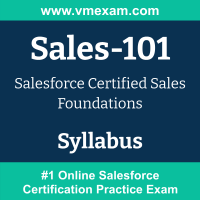 The Salesforce Sales-101 exam preparation guide is designed to provide candidates with necessary information about the Sales Foundations exam. It includes exam summary, sample questions, practice test, objectives and ways to interpret the exam objectives to enable candidates to assess the types of questions-answers that may be asked during the Salesforce Certified Sales Foundations exam.
The Salesforce Sales-101 exam preparation guide is designed to provide candidates with necessary information about the Sales Foundations exam. It includes exam summary, sample questions, practice test, objectives and ways to interpret the exam objectives to enable candidates to assess the types of questions-answers that may be asked during the Salesforce Certified Sales Foundations exam.
It is recommended for all the candidates to refer the Sales-101 objectives and sample questions provided in this preparation guide. The Salesforce Sales Foundations certification is mainly targeted to the candidates who want to build their career in Sales Professional domain and demonstrate their expertise. We suggest you to use practice exam listed in this cert guide to get used to with exam environment and identify the knowledge areas where you need more work prior to taking the actual Salesforce Certified Sales Foundations exam.
Salesforce Sales-101 Exam Summary:
|
Exam Name
|
Salesforce Certified Sales Foundations |
| Exam Code | Sales-101 |
| Exam Price |
Registration fee: USD 75 Retake fee: Free |
| Duration | 105 minutes |
| Number of Questions | 45 |
| Passing Score | 70% |
| Recommended Training / Books |
Cert Prep: Salesforce Sales Foundations Prepare for your Salesforce Sales Foundations |
| Schedule Exam |
Kryterion Webassessor PEARSON VUE |
| Sample Questions | Salesforce Sales-101 Sample Questions |
| Recommended Practice | Salesforce Certified Sales Foundations Practice Test |
Salesforce Sales Foundations Syllabus:
| Section | Objectives | Weight |
|---|---|---|
| Planning |
- Describe the elements of territory planning.
- Create an approach to engage key accounts. - Calculate sales quota attainability based on account, territory, and prospect insights. - Develop business relationships and build partnerships with key roles and personas. |
21% |
| Customer Engagement |
- Demonstrate thought leadership and build credibility to shift the customer's thinking.
- Leverage multiple touchpoints to build prospect interest and align on why a solution meets their needs. - Nurture relationships and drive product adoption to maximize value for the customer. |
15% |
| Deal Management |
- Identify how to qualify a prospect and when to move to the next stage of the sales process.
- Determine customer's business strategies, goals, initiatives, and challenges to define the scope of the solution. - Develop and present the value proposition of a solution based on customer needs. - Identify and remove all challenges to finalize the deal. - Gain customer commitment and close formal contract. |
37% |
| Pipeline Management |
- Identify and generate new pipeline.
- Analyze pipeline health insights ensuring data integrity to improve customer relevance. - Explain pipe progression and stage velocity. |
12% |
| Forecasting |
- Assess forecast accuracy to drive opportunity consistency.
- Measure the risks and opportunities associated with a business deal. - Explain key inputs that drive the forecasting process. |
6% |
| Customer Success |
- Identify the actions needed to book and fulfill orders.
- Identify the post-sales customer journey. - Assess customer realized and expected value. |
9% |
